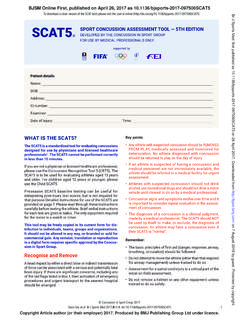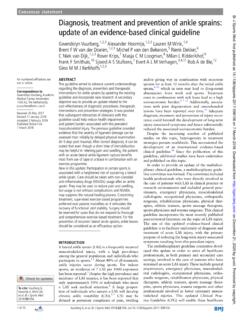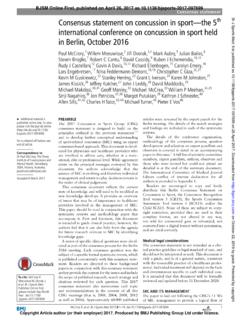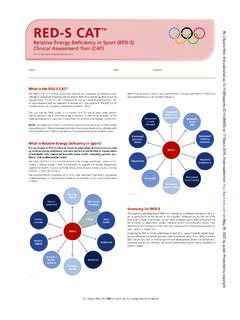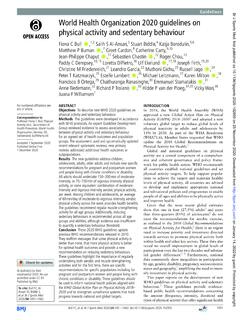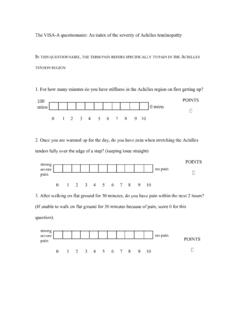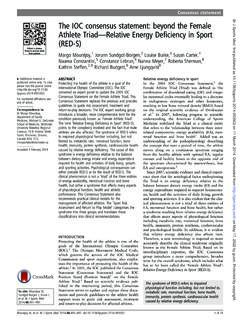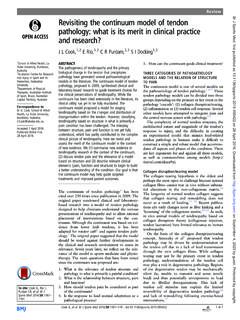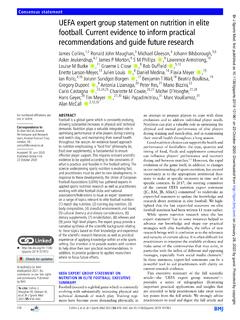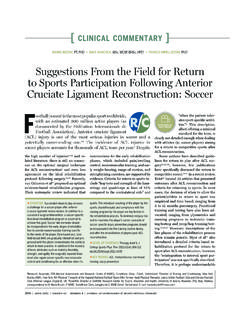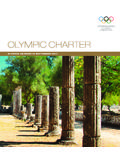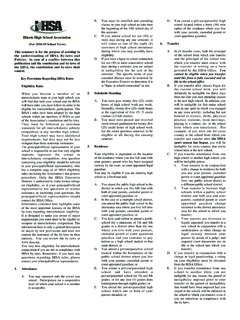Transcription of Concussion recognition tool 5© - British Journal of ...
1 1 Davis GA, et al. Br J Sports Med 2017;0:1. download a clean version of the SCAT tools please visit the Journal online ( ) Concussion in Sport Group 2017 Concussion recognition tool 5 To help identify Concussion in children, adolescents and adults Concussion in Sport Group 2017 Concussion in Sport Group 2017 RECOGNISE & REMOVEHead impacts can be associated with serious and potentially fatal brain injuries. The Concussion recognition tool 5 (CRT5) is to be used for the identification of suspected Concussion . It is not designed to diagnose 1: RED FLAGS CALL AN AMBULANCEIf there is concern after an injury including whether ANY of the following signs are observed or complaints are reported then the player should be safely and immediately removed from play/game/activity. If no licensed healthcare professional is available, call an ambulance for urgent medical assessment: Neck pain or tenderness Double vision Weakness or tingling/burning in arms or legs Severe or increasing headache Seizure or convulsion Loss of consciousness Deteriorating conscious state Vomiting Increasingly restless, agitated or combativeSupported byRemember: In all cases, the basic principles of first aid (danger, response, airway, breathing, circulation) should be followed.
2 Assessment for a spinal cord injury is critical. Do not attempt to move the player (other than required for airway support) unless trained to so do. Do not remove a helmet or any other equipment unless trained to do so there are no Red Flags, identification of possible Concussion should proceed to the following steps:STEP 2: OBSERVABLE SIGNSV isual clues that suggest possible Concussion include: Lying motionless on the playing surface Slow to get up after a direct or indirect hit to the head Disorientation or confusion, or an inability to respond appropriately to questions Blank or vacant look Balance, gait difficulties, motor incoordination, stumbling, slow laboured movements Facial injury after head traumaSTEP 3: SYMPTOMS Headache Pressure in head Balance problems Nausea or vomiting Drowsiness Dizziness Blurred vision Sensitivity to light Sensitivity to noise Fatigue or low energy Don t feel right More emotional More Irritable Sadness Nervous or anxious Neck Pain Difficulty concentrating Difficulty remembering Feeling slowed down Feeling like in a fog STEP 4: MEMORY ASSESSMENT (IN ATHLETES OLDER THAN 12 YE ARS)Failure to answer any of these questions (modified appropriately for each sport) correctly may suggest a Concussion : What venue are we at today?
3 Which half is it now? Who scored last in this game? What team did you play last week/game? Did your team win the last game? Athletes with suspected Concussion should: Not be left alone initially (at least for the first 1-2 hours). Not drink alcohol. Not use recreational/ prescription drugs. Not be sent home by themselves. They need to be with a responsible adult. Not drive a motor vehicle until cleared to do so by a healthcare CRT5 may be freely copied in its current form for distribution to individuals, teams, groups and organisations. Any revision and any reproduction in a digital form requires approval by the Concussion in Sport Group. It should not be altered in any way, rebranded or sold for commercial ATHLETE WITH A SUSPECTED Concussion SHOULD BE IMMEDIATELY REMOVED FROM PRACTICE OR PLAY AND SHOULD NOT RETURN TO ACTIVITY UNTIL ASSESSED MEDICALLY, EVEN IF THE SYMPTOMS RESOLVE BJSM Online First, published on April 26, 2017 as Article author (or their employer) 2017.
4 Produced by BMJ Publishing Group Ltd under licence. on May 8, 2022 by guest. Protected by J Sports Med: first published as on 26 April 2017. Downloaded from
